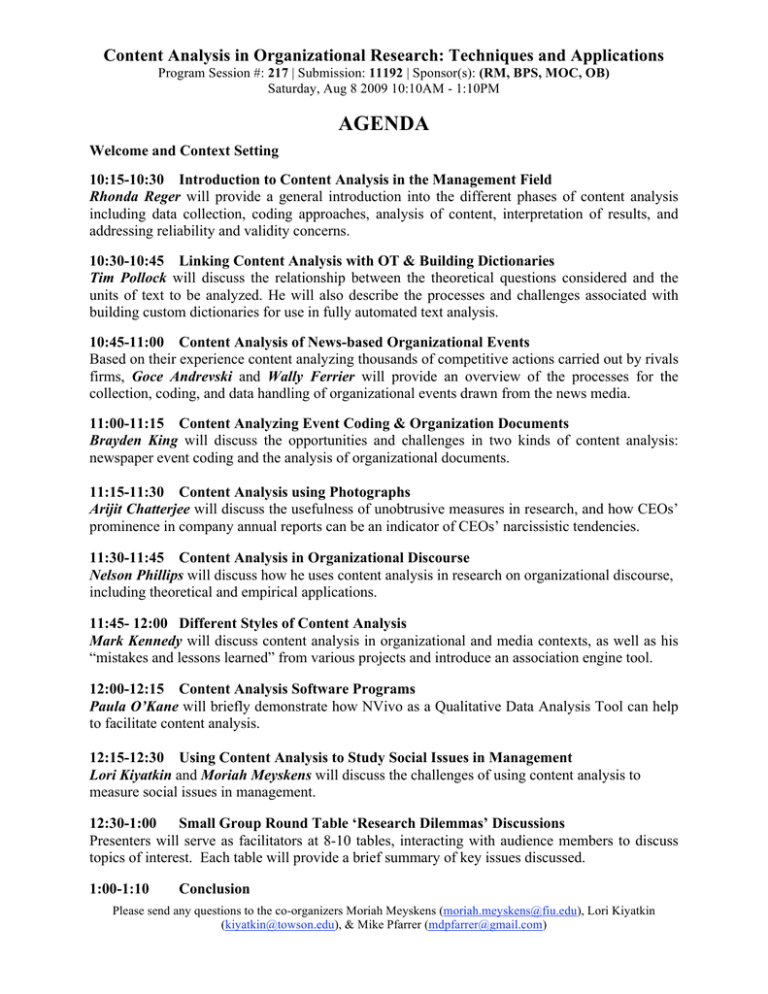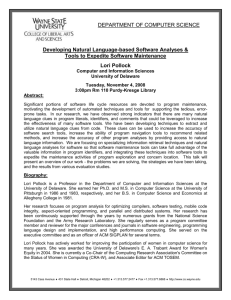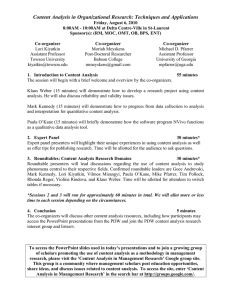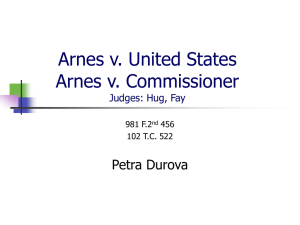AGENDA Content Analysis in Organizational Research: Techniques and Applications
advertisement

Content Analysis in Organizational Research: Techniques and Applications Program Session #: 217 | Submission: 11192 | Sponsor(s): (RM, BPS, MOC, OB) Saturday, Aug 8 2009 10:10AM - 1:10PM AGENDA Welcome and Context Setting 10:15-10:30 Introduction to Content Analysis in the Management Field Rhonda Reger will provide a general introduction into the different phases of content analysis including data collection, coding approaches, analysis of content, interpretation of results, and addressing reliability and validity concerns. 10:30-10:45 Linking Content Analysis with OT & Building Dictionaries Tim Pollock will discuss the relationship between the theoretical questions considered and the units of text to be analyzed. He will also describe the processes and challenges associated with building custom dictionaries for use in fully automated text analysis. 10:45-11:00 Content Analysis of News-based Organizational Events Based on their experience content analyzing thousands of competitive actions carried out by rivals firms, Goce Andrevski and Wally Ferrier will provide an overview of the processes for the collection, coding, and data handling of organizational events drawn from the news media. 11:00-11:15 Content Analyzing Event Coding & Organization Documents Brayden King will discuss the opportunities and challenges in two kinds of content analysis: newspaper event coding and the analysis of organizational documents. 11:15-11:30 Content Analysis using Photographs Arijit Chatterjee will discuss the usefulness of unobtrusive measures in research, and how CEOs’ prominence in company annual reports can be an indicator of CEOs’ narcissistic tendencies. 11:30-11:45 Content Analysis in Organizational Discourse Nelson Phillips will discuss how he uses content analysis in research on organizational discourse, including theoretical and empirical applications. 11:45- 12:00 Different Styles of Content Analysis Mark Kennedy will discuss content analysis in organizational and media contexts, as well as his “mistakes and lessons learned” from various projects and introduce an association engine tool. 12:00-12:15 Content Analysis Software Programs Paula O’Kane will briefly demonstrate how NVivo as a Qualitative Data Analysis Tool can help to facilitate content analysis. 12:15-12:30 Using Content Analysis to Study Social Issues in Management Lori Kiyatkin and Moriah Meyskens will discuss the challenges of using content analysis to measure social issues in management. 12:30-1:00 Small Group Round Table ‘Research Dilemmas’ Discussions Presenters will serve as facilitators at 8-10 tables, interacting with audience members to discuss topics of interest. Each table will provide a brief summary of key issues discussed. 1:00-1:10 Conclusion Please send any questions to the co-organizers Moriah Meyskens (moriah.meyskens@fiu.edu), Lori Kiyatkin (kiyatkin@towson.edu), & Mike Pfarrer (mdpfarrer@gmail.com) Content Analysis in Organizational Research: Techniques and Applications Program Session #: 217 | Submission: 11192 | Sponsor(s): (RM, BPS, MOC, OB) Saturday, Aug 8 2009 10:10AM - 1:10PM To view the presenters’ slides and updates regarding this topic please visit http://sites.google.com/site/contentanalysispdw/ Selected References Chatterjee, A. & Hambrick, D. C. 2007. It's all about me: Narcissistic chief executive officers and their effects on company strategy and performance. Administrative Science Quarterly, 52: 351386. Duriau, V. J., Reger, R.R., & Pfarrer, M.D. 2007. A content analysis of the content analysis literature in organizational studies: Research themes, data sources, and methodological refinements. Organizational Research Methods, 10: 5-34. Kennedy, M. T. 2008. Getting counted: Markets, media, and reality. American Sociological Review, 73: 1021-1021. King, B. G. 2008. A political mediation model of corporate response to social movement activism. Administrative Science Quarterly, 53: 395-421. Krippendorf, K. 2004. Content analysis: An introduction to its methodology. Thousand Oaks, CA: Sage. Neuendorf. The Content Analysis Guidebook http://academic.csuohio.edu/kneuendorf/content/resources/car.htm O’Kane, P., & Owen, H. 2007. Intentional and unintentional consequences of substituting face-toface interaction with e-mail: An employee-based perspective. Interacting with Computers, 19: 20-31 Phillips, N., Lawrence, T. B., & Hardy, C. 2004. Discourse and institutions. Academy of Management Review, 29: 635-652. Pollock, T.G., & Rindova, V. P. 2003. Media legitimation effects in the market for initial public offerings. Academy of Management Journal, 46: 631-642. Stone, P.J., Dunphy, D.C., Smith, M.S., & Ogilvi, D.M. 1966. The general inquirer: A computer approach to content analysis. Cambridge: MIT Press. Wade, J.B., Porac, J.F. & Pollock, T.G. 1997. Worth, words and the justification of executive pay. Journal of Organizational Behavior, 18: 641-664. Select Content Analysis Programs and Websites • http://courses.washington.edu/socw580/contentsoftware.shtml • http://www.content-analysis.de/2008/03/11/software-for-content-analysis-a-review.html • Nvivo http://www.qsrinternational.com/ • Text Analysis http://www.textanalysis.info/ • Wordstat http://www.provalisresearch.com/ Please send any questions to the co-organizers Moriah Meyskens (moriah.meyskens@fiu.edu), Lori Kiyatkin (kiyatkin@towson.edu), & Mike Pfarrer (mdpfarrer@gmail.com)





